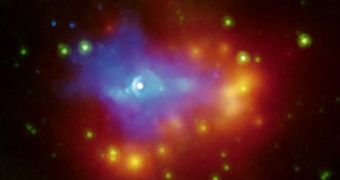Supernovae are without any doubt some of the most energetic outbursts of energy in the entire Universe. At times, they can blow up so fiercely, that they produce flashes of light which briefly outshine entire galaxies, as viewed from our vantage point. They produce vast amount of radiation, promote the development of cosmic dust, and also tend to create what is called a “remnant” around the collapsed core of its former central star. Now, for the first time ever, researchers get a chance to look at this dust.
This is extremely important, as astronomers have been hypothesizing about how this material may be produced, and what its main traits might be, for a very long time. However, it is generally very difficult to observe the stuff in average supernovae explosions, as infrared observatories are best suited for the job. But the dust remains invisible in these wavelengths until it is heavily energized by blast waves from the supernova it envelops. However, as this happens, most of the fine particles are destroyed, rendering investigations useless, Space reports.
But a new series of observations appears capable of breaking this spell. Readings collected by two of the American space agency's four Great Observatories, the Chandra and Spitzer space telescopes, show a rare celestial object, and it has been dubbed G54.1+0.3. It is basically a supernova remnant, seen here flying through, and engulfing, a group of stars close to its location. The central area of the image, with its white dot, is the neutron star that formed at the core of the former star during the supernova explosion. The fast-spinning star, called a pulsar, is emitting large amounts of high-energy particles, which push the dust nearby outwards.
As this happens, heat from the stars begins to bring the gas and dust that condensed from the explosion to higher temperatures, which essentially means that the fine particles are warmed from an external source. This is a unique scenario, and one that allows astronomers considerably more insight into the amount and structure of the dust that comes out of supernovae. The particle winds have been photographed using Chandra, which is especially suitable to observing the Universe in the X-ray region of the electromagnetic spectrum. The dust particles themselves have been inspected using Spitzer's infrared capacities.

 14 DAY TRIAL //
14 DAY TRIAL //